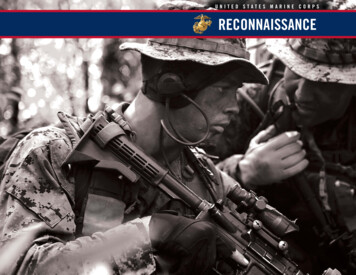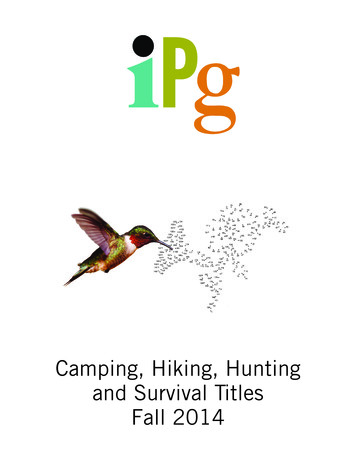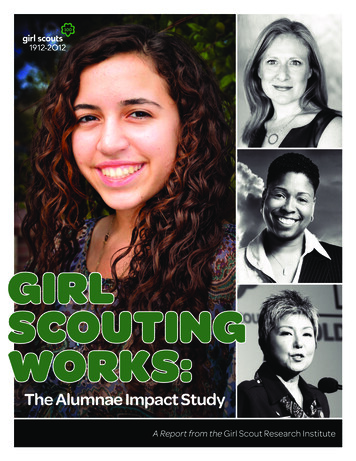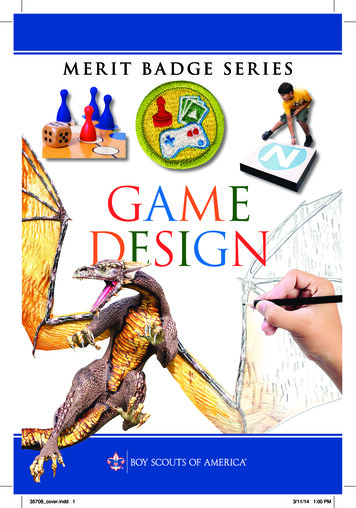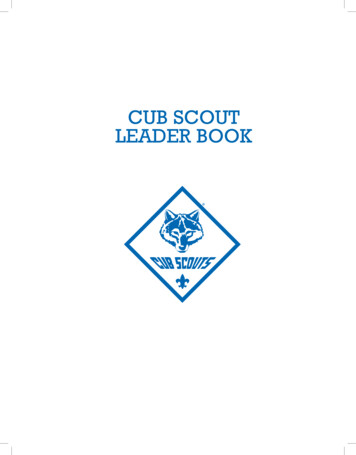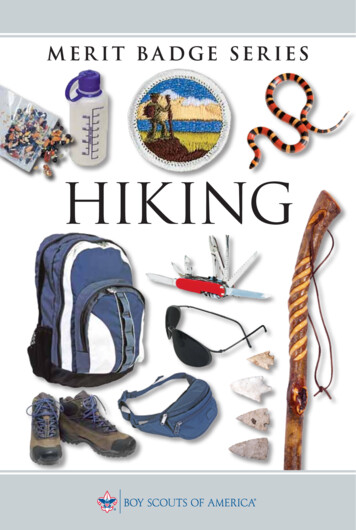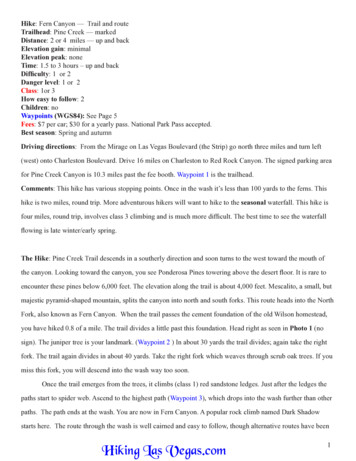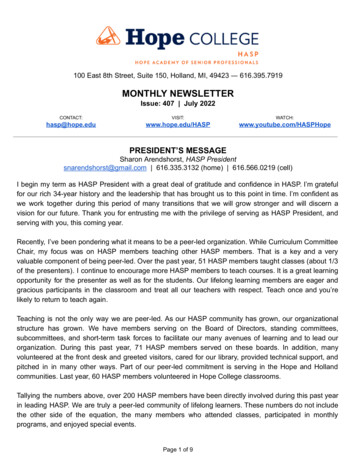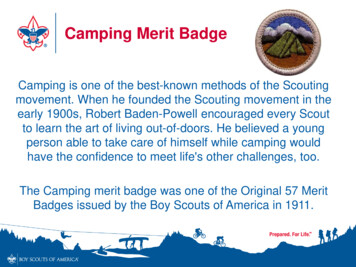
Transcription
HIKING
BOY SCOUTS OF AMERICAMERIT BADGE SERIESHIKING“Enhancing our youths’ competitive edge through merit badges”
Requirements1. Do the following:a. Explain to your counselor the most likely hazards you may encounterwhile hiking, and what you should do to anticipate, help prevent, mitigate,and respond to these hazards.b. Show that you know first aid for injuries or illnesses that could occurwhile hiking, including hypothermia, frostbite, dehydration, heat exhaustion,heatstroke, sunburn, hyperventilation, altitude sickness, sprained ankle, blisters, insect stings, tick bites, and snakebite.2. Explain and, where possible, show the points of good hiking practices includingproper outdoor ethics, hiking safety in the daytime and at night, courtesy to others, choice of footwear, and proper care of feet and footwear.3. Explain how hiking is an aerobic activity. Develop a plan for conditioningyourself for 10-mile hikes, and describe how you will increase your fitnessfor longer hikes.4. Take the five following hikes, each on a different day, and each of continuousmiles. These hikes MUST be taken in the following order:One 5-mile hikeThree 10-mile hikesOne 15-mile hikeYou may stop for as many short rest periods as needed, as well as one meal,during each hike, but not for an extended period (example: overnight). Preparea written hike plan before each hike and share it with your Scoutmaster or adesignee. Include map routes, a clothing and equipment list, and a list of itemsfor a trail lunch.**The required hikes for this badge may be used in fulfilling hiking requirements for rank advancement.However, these hikes cannot be used to fulfill requirements of other merit badges.35907ISBN 978-0-8395-3407-8 2016 Boy Scouts of America2016 Printing
5. Take a hike of 20 continuous miles in one day following a hike plan youhave prepared. You may stop for as many short rest periods as needed,as well as one meal, but not for an extended period (example: overnight).*6. After each of the hikes (or during each hike if on one continuous “trek”)in requirements 4 and 5, write a short reflection of your experience. Give datesand descriptions of routes covered, the weather, and any interesting thingsyou saw. It may include something you learned about yourself, about the outdoors, or about others you were hiking with. Share this with your meritbadge counselor.HIKING 3
.Hiking ResourcesHiking ResourcesScouting LiteratureBoy Scout Handbook; Fieldbook; Deck ofFirst Aid; Basic Illustrated WildernessFirst Aid; Emergency First Aid pocketguide; Be Prepared First Aid Book;Conservation Handbook; Backpacking,Camping, Cooking, First Aid, Geocaching,Orienteering, and Wilderness Survivalmerit badge pamphletsVisit the Boy Scouts of America’sofficial retail website at http://www.scoutstuff.org for a complete listing of all merit badgepamphlets and other helpfulScouting materials and supplies.Instruction and GuidebooksAnderson, Kristi. Wilderness Basics,4th ed. Mountaineers Books, 2013.Berger, Karen. More Everyday Wisdom:Trail-Tested Advice From the Experts.Mountaineers Books, 2002.———. Hiking and Backpacking. DKPublishing, 2008.———. Hiking Light Handbook: CarryLess, Enjoy More. BackpackerMagazine, Mountaineers Books, 2004.Birkby, Robert. Lightly on the Land:The SCA Trail Building andMaintenance Manual, 2nd ed.Mountaineers Books, 2006.Burns, Bob. Wilderness Navigation:Finding Your Way Using Map,Compass, Altimeter and GPS, 3rd ed.Mountaineers Books, 2015.Carline, Jan. Mountaineering First Aid:A Guide to Accident Responseand First Aid Care. MountaineersBooks, 2004.Cole, David. NOLS Soft Paths: Enjoyingthe Wilderness Without Harming It,4th ed. Stackpole Books, 2011.Fleming, June. Staying Found: TheComplete Map and CompassHandbook, 3rd ed. MountaineersBooks, 2001.Fletcher, Colin, and Chip Rawlins. TheComplete Walker IV. Knopf, 2002.Forgey, William. Basic Illustrated:Wilderness First Aid, 2nd ed.Falcon Guides, 2015.Graham, John. Outdoor Leadership:Technique, Common Sense, andSelf-Confidence. MountaineersBooks, 1997.HIKING 61
Hiking Resources.Grubbs, Bruce. Exploring WithGPS: A Practical Field Guide forSatellite Navigation. Bright AngelPress, 2014.Hooks, Christine. Essential Hiking forTeens. Children’s Press, 2000.Jacobson, Cliff. Basic Illustrated:Map and Compass, 3rd ed. FalconGuides, 2008.Jacobson, Cliff, Scottie Barnes, andJames Churchill. The Ultimate Guideto Wilderness Navigation. LyonsPress (Globe Pequot Press), 2002.Kals, W.S., and Clyde Soles. LandNavigation Handbook: The SierraClub Guide to Map, Compass, andGPS, 2nd ed. Counterpoint, 2010.Lanza, Michael. The Day Hiker’sHandbook: Get Started With theExperts. Mountaineers Books, 2003.Logue, Victoria. Hiking and Backpacking:Essential Skills, Equipment, andSafety, 2nd ed. Menasha RidgePress, 2013.———. Kids Outdoors: Skills andKnowledge for Outdoor Adventures.Ragged Mountain, 1996.Marion, Jeffrey. Leave No Trace in theOutdoors. Stackpole Books, 2014.McVey, Vicki. The Sierra ClubWayfinding Book. Sierra ClubJuveniles, 1991.Musnick, David, and Mark Pierce.Conditioning for Outdoor Fitness.Mountaineers Books, 2004.Robbins, Michael W. The HikingCompanion. Storey Books, 2003.Schimelpfenig, Tod, and Linda Lindsey.NOLS Wilderness First Aid, 5th ed.Stackpole Books, 2013.Tilton, Buck. Outdoor Safety Handbook.Stackpole Books, 2006.Organizations and WebsitesAmerican Hiking Society1422 Fenwick LaneSilver Spring, MD 20910Toll-free telephone: 800-972-8608Website: http://www.americanhiking.orgLeave No Trace Center forOutdoor EthicsP.O. Box 997Boulder, CO 80306Toll-free telephone: 800-332-4100Website: http://www.LNT.orgLocal HikesWebsite: http://www.localhikes.comMcGivney, Annette. Leave No Trace: AGuide to the New WildernessEtiquette, 2nd rev. ed. MountaineersBooks, 2003.Sierra Club85 Second St., Second FloorSan Francisco, CA 94105-3441Telephone: 415-977-5500Website: http://www.sierraclub.orgMcKinney, John. The Joy of Hiking:Hiking the Trailmaster Way.Wilderness Press, 2005.Student Conservation AssociationToll-free telephone: 888-722-9675Website: http://www.thesca.org62 HIKING
.Hiking ResourcesMagazinesBackpacker MagazineWebsite: http://www.backpacker.comCamping Life MagazineWebsite: http://www.campinglife.comAcknowledgmentsThe Boy Scouts of America is gratefulto the men and women serving on theMerit Badge Maintenance Task Forcefor the improvements made in updatingthis pamphlet.Photo and Illustration CreditsHansell F. Cross, Georgia StateUniversity, Bugwood.org, courtesy—page 56 (chigger)Library of Congress Prints andPhotographs Division, courtesy—pages 6 (1906 photo) and 7 (1906,1912 photos)Shutterstock.com, courtesy—cover(day pack, Yuliyan Velchev; fannypack, nito; knife, Jonas Staub;sunglasses, Stocksnapper); pages12 (traffic light, picsbyst; trash bin, Bikeworldtravel), 14 (sunglasses, Stocksnapper), 15 (snowshoes, marekuliasz), 16 ( robert cicchetti),17 (cairns, Zyankarlo), 19 (lizard, Steve Bower), 26 ( val lawless), 35(fanny pack, nito; day pack, Yuliyan Velchev), 36 (trekkingpole, Rafa Irusta), 40 (porcupine, A Lein), 50 ( kavram), 58( AndreaTS), and 59 (stripedskunk, Critterbiz)USDA Agricultural Resource Service/Scott Bauer, courtesy—page 56 (tick)U.S. Fish and Wildlife Service/KenHammond, courtesy—page 13 (moose)Wikipedia.org, courtesy—6 (ladybirdbeetles), 23 (Canada geese),27 (nest), 28 (ground squirrel,mallard, raccoon, prairie dog),39, 55, and 59 (coyote)All other photos and illustrations notmentioned above are the property ofor are protected by the Boy Scoutsof America.Dan Bryant—page 34 (gloves)Daniel Giles—page 52Roy Jansen—pages 41–42John McDearmon—page 49(ankle wrapping)Brian Payne—cover (milk snake);pages 4, 10, 14 (applying sunscreen),15 (Scouts in snow), 18, 19 (drystreambed), 30 (track, basketball),31, 32 (cleaning shoes), 36 (Scoutwith trekking poles), 38, 40 (Scoutlooking back), 51, 57, and 60Randy Piland—page 43HIKING 63
HIKING 61.Hiking Resources Scouting Literature Boy Scout Handbook; Fieldbook; Deck of First Aid; Basic Illustrated Wilderness First Aid; Emergency First Aid pocket guide; Be Prepared First Aid Book; Conservation Handbook; Backpacking,
